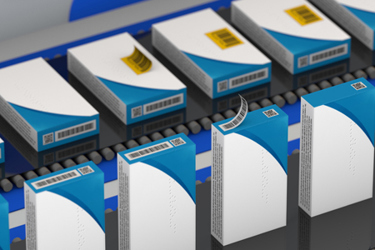Emerging Trends & Technologies In Anti-Counterfeit Pharmaceutical Packaging
By Aashi Mishra, Research Nester

Falsified and substandard medical products pose an exponentially rising problem that is occurring all throughout the world. Counterfeit medicines are rising at an alarming rate, with data showing that nearly 6,500 pharmaceutical crime incidents were recorded in 2021. Research Nester found that fake drugs kill almost 250,010 children in a year. Chemicals like paint, printer ink, and arsenic are found in some of these medicines. These falsified medicines can be found on unregulated websites, illegal street markets, etc.
In terms of the geographical distribution of counterfeit pharmaceutical seizures, the numbers of recorded cases in 2019 (the most recent numbers we could find) are as follows:
- North America: 2,440
- Asia Pacific: 1,749
- Latin America: 771
- Near East: 706
- Eurasia: 648
- Europe: 375
- Africa: 189
In addition, the WHO states that almost 10% of medical products in the market in middle- and low-income countries are falsified. There are various threats posed by these substandard products, such as:
- The medicines can be toxic and even fatal.
- These medicines can fail to prevent the diseases they purport to treat.
- The falsified medicines contain no active ingredients.
- The medicines appear genuine and thus are difficult to detect.
A myriad of counterfeit medicines is available, from innovator drugs to generics, including antimalarials, antibiotics, cholesterol-lowering medicines, blood pressure medicines, analgesics, cancer treatments, steroids, vaccines, and HIV and tuberculosis treatments. Hence, the United Nations has already warned that counterfeit products are ranked among the highest income sources for organized crime. Doctors have recommended upgrading the UN's sustainable development goals so that the global agency would ensure at least 90% of medicines are of standard quality.
By incorporating anti-counterfeit medical product protection, companies are saving customers from fake medicines and fortifying their brand value. Let’s look at the key features and key technologies being used in anti-counterfeit pharmaceutical packaging.
Anti-counterfeit Features
Key features being used include tamper-evident solutions, forensic markers, overt features, covert features, and track & trace technologies. Let’s look at each one.
Tamper-Evidence Solutions
Tamper-evident seals and labels are frequently employed to indicate whether a package has been opened or tampered with. These seals can be designed in such a way that they display a message or reveal a hidden pattern upon removal, making it challenging for anyone to reproduce or substitute the seal. Additionally, incorporating color-shifting inks into packaging can further enhance its resistance by causing the colors to change when viewed from different angles or under various lighting conditions.
Forensic Markers
Forensic markers serve as identifiers that aid in the detection of counterfeit pharmaceuticals. These markers, which cannot be seen without special equipment, are incorporated into the packaging of pharmaceutical products during manufacturing. Each batch of products possesses its unique set of markers enabling verification of product authenticity by comparing the marker on the packaging with the corresponding entry in the manufacturer’s database.
Overt Features
Overt features, like holograms or color-shifting inks, are commonly used in anti-counterfeit pharmaceutical packaging. Holograms are particularly effective as they are hard to replicate and are easily recognizable by consumers. Color-shifting inks change their color when viewed from different angles, making them difficult to duplicate. Another method used is embossing, which involves creating a raised design or pattern on the packaging surface. This technique adds a layer of difficulty for counterfeiters and can serve as a clear indicator of authenticity. Additionally, QR codes and bar codes can be implemented as overt features that consumers to scan to verify the genuineness of the product.
Covert Features
Invisible ink is a popular covert feature that can be used to print unique codes or symbols on packaging that are only visible under specific conditions, such as under UV light. The purpose of this feature is to verify the authenticity of the product and keep track of it as it moves through the supply chain. Additionally, there's a method called microtext, which involves printing text or images that are challenging to read without magnification. This technique serves two purposes: authenticating the product and deterring counterfeiters who lack the technology to accurately replicate microtext.
We’ll look a little more closely at some of these overt and covert features later in this article.
Track & Trace Technologies
Serialization is the process of assigning a unique code to each individual unit of a product. This code allows for tracking and authentication throughout the entire supply chain, particularly in the pharmaceutical industry where it plays a crucial role in preventing counterfeiting. Bar-coding technology is widely used to facilitate tracking and tracing of products as they move through the supply chain. It not only helps verify the authenticity of products but also serves as a deterrent to counterfeiting. Another technology, known as RFID, utilizes radio waves to identify and track products in time. This advanced technology enables tracking and tracing of products, ensuring transparency within the supply chain while effectively combating counterfeiting.
Anti-counterfeit Technologies
Key technologies being used include RFID, holograms, security printing and graphics, security ink coatings, and mass encoding. Let’s look at each one.
RFID
By technology segment, RFID technology is being used the most in anti-counterfeit pharmaceutical packaging due to its high accuracy and efficiency in tracking and identifying products along with its real time monitoring capabilities. For instance, an article published by PubMed Central in August 2022 highlighted the advancements in applications such as real-time locating systems (RTLS) for analyzing medical personnel management. These developments are expected to drive growth in the RFID industry in the coming years.
RFID technology utilizes radio waves to transmit information between a tag and a reader. It is extensively used across industries, including pharmaceuticals, for tracking and identification purposes. RFID tags can store large amounts of data and can be read from a distance, making them highly suitable for efficiently tracking and identifying pharmaceutical products. Additionally, they facilitate real-time monitoring, enabling detection of counterfeit products and preventing their distribution.
Holograms
Holograms are widely used in anti-counterfeit pharmaceutical packaging. They are challenging to counterfeit, which makes them an excellent deterrent against counterfeiters. Holograms can be incorporated into packaging through methods such as using stickers or labels or by directly printing them onto the packaging material. Additionally, they can be combined with security measures like serial numbers or QR codes to further enhance protection.
Security Ink Coatings
Security ink coatings are also widely used to prevent counterfeiting. They are known for their durability and ability to resist tampering. These coatings can be applied to types of packaging materials like plastic and paper and can be personalized with distinct patterns or designs to enhance security measures. Moreover, they can be easily validated using detection techniques such as UV light or chemical testing. Some examples of inks are:
- Invisible fluorescent ink
- Infrared excitation inks
- Photochromic inks
- Luminous inks
- Coin reactive inks
- Mirror inks
- Laser hologram inks
Mass Encoding
Mass encoding is a cutting-edge technique employed in anti-counterfeit pharmaceutical packaging with the primary purpose of embedding extensive amounts of information directly onto the package. This innovative technology enables the tracking and monitoring of individual packages throughout their entire journey within the supply chain, effectively safeguarding them against any potential tampering or counterfeiting. Mass encoding proves valuable when it comes to high-demand products like over-the-counter medications, where there exists a pressing need to closely monitor and track large quantities of packages.
Key Vendor Companies Operating In The Space
- Avery Dennison Corporation
- CCL Industries Inc.
- DuPont de Nemours, Inc.
- AlpVision S.A.
- SICPA HOLDING SA
- Applied DNA Sciences Inc.
- ATL Corp.
- Alien Technology, LLC
- Authentix, Inc.
- Impinj, Inc.
This article shares insights from Research Nester’s market research report on anti-counterfeit pharmaceutical packaging.
 About The Author:
About The Author:
Aashi Mishra is a content developer at Research Nester and is also an electronics engineer. She has three years of market research experience.
